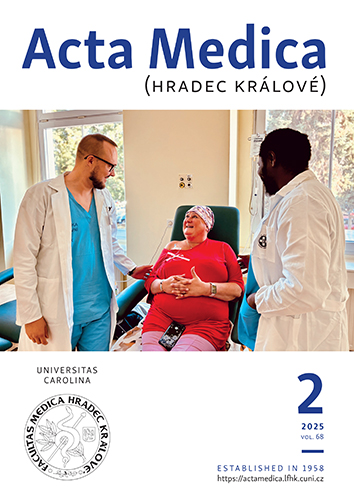ACTA MEDICA, Vol 63 No 2 (2020), 73–78
Fluoroscopic Epidural Steroid Injection: Pain Relief in Discogenic Sciatic Versus Lumbar Spinal Stenosis. A Study on Middle Eastern Patients
Todor Shamov, Jasem Y. Al-Hashel, Rossen T. Rоusseff
DOI: https://doi.org/10.14712/18059694.2020.20
published online: 10. 08. 2020
abstract
Objective: To compare the effect of epidural steroid injections (ESI) in patients with discogenic sciatica (Sci) versus patients with lumbar canal stenosis (LSS), not controlled by conservative treatment. Materials and methods: In our study, 80 patients with Sci and 66 with LSS were included. A single ESI (10 mg dexamethasone in 3 cc 0.25% bupivacaine) was applied under fluoroscopic control: one level above the highest stenotic level, in the posterior epidural space, via interlaminar approach in LSS and at the prolapse level, in the anterior epidural space, via transforaminal route in Sci. Pain intensity was assessed by VAS at baseline and on days 1, 15 and 30 after intervention. Results: The procedure was successful in 78 Sci and 63 LSS patients. Patients with Sci responded significantly better. At one month, pain reduction over 50% was achieved in 63% (52.3–73.7% at p = 0.95) of Sci but only in 35% (23.2–46.8%) of LSS (p = 0.03). Return to pre-intervention level happened in 47% (34.7–59.3%) of LSS versus 14% (6.3–21.7%) of Sci patients (p = 0.01). In 5 patients the procedure failed, without resulting morbidity. Conclusion: ESI are more effective in patients with Sci than in single level LSS. In multiple level LSS, results are disappointing.
keywords: epidural steroid injections; intervertebral disc disease; lumbar spinal stenosis; low back pain; sciatica; chronic pain; neuropathic pain

Fluoroscopic Epidural Steroid Injection: Pain Relief in Discogenic Sciatic Versus Lumbar Spinal Stenosis. A Study on Middle Eastern Patients is licensed under a Creative Commons Attribution 4.0 International License.
210 x 297 mm
periodicity: 4 x per year
print price: 150 czk
ISSN: 1211-4286
E-ISSN: 1805-9694
